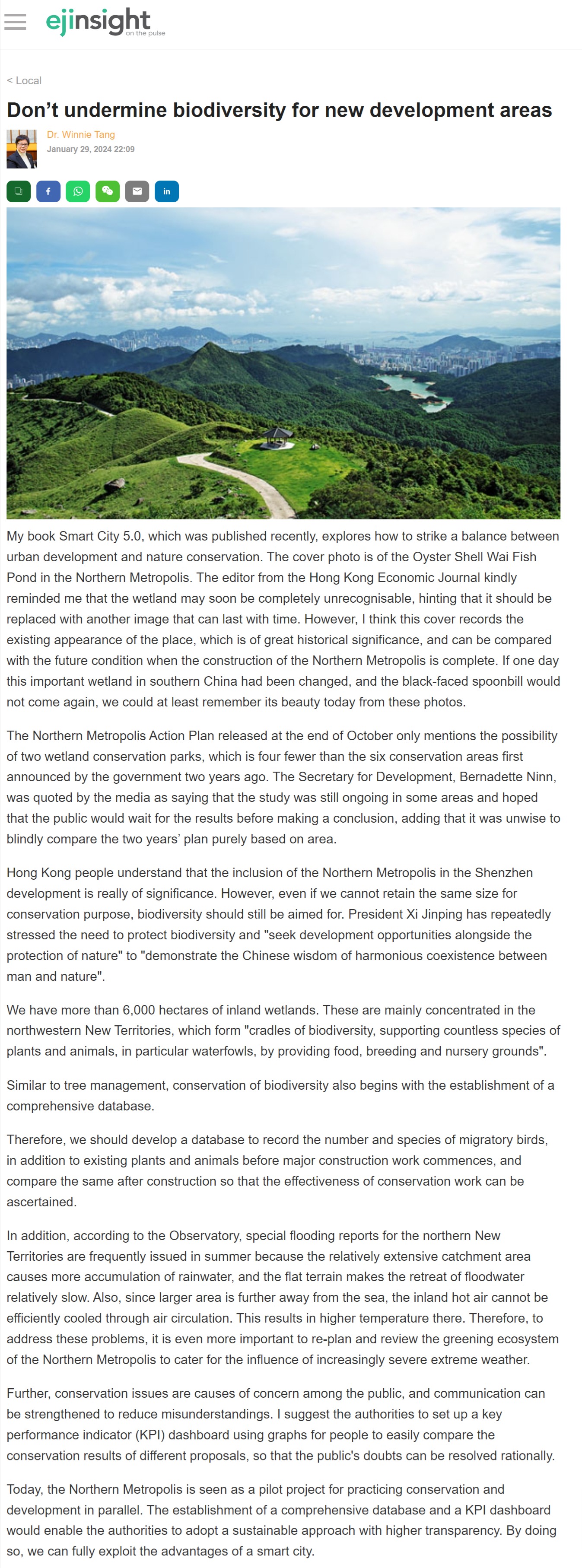網上版請按此

Don't undermine biodiversity for new development areas
My book Smart City 5.0, which was published recently, explores how to strike a balance between urban development and nature conservation. The cover photo is of the Oyster Shell Wai Fish Pond in the Northern Metropolis. The editor from the Hong Kong Economic Journal kindly reminded me that the wetland may soon be completely unrecognisable, hinting that it should be replaced with another image that can last with time. However, I think this cover records the existing appearance of the place, which is of great historical significance, and can be compared with the future condition when the construction of the Northern Metropolis is complete. If one day this important wetland in southern China had been changed, and the black-faced spoonbill would not come again, we could at least remember its beauty today from these photos.
The Northern Metropolis Action Plan released at the end of October only mentions the possibility of two wetland conservation parks, which is four fewer than the six conservation areas first announced by the government two years ago. The Secretary for Development, Bernadette Ninn, was quoted by the media as saying that the study was still ongoing in some areas and hoped that the public would wait for the results before making a conclusion, adding that it was unwise to blindly compare the two years' plan purely based on area.
Hong Kong people understand that the inclusion of the Northern Metropolis in the Shenzhen development is really of significance. However, even if we cannot retain the same size for conservation purpose, biodiversity should still be aimed for. President Xi Jinping has repeatedly stressed the need to protect biodiversity and "seek development opportunities alongside the protection of nature" to "demonstrate the Chinese wisdom of harmonious coexistence between man and nature".
We have more than 6,000 hectares of inland wetlands. These are mainly concentrated in the northwestern New Territories, which form "cradles of biodiversity, supporting countless species of plants and animals, in particular waterfowls, by providing food, breeding and nursery grounds".
Similar to tree management, conservation of biodiversity also begins with the establishment of a comprehensive database.
Therefore, we should develop a database to record the number and species of migratory birds, in addition to existing plants and animals before major construction work commences, and compare the same after construction so that the effectiveness of conservation work can be ascertained.
In addition, according to the Observatory, special flooding reports for the northern New Territories are frequently issued in summer because the relatively extensive catchment area causes more accumulation of rainwater, and the flat terrain makes the retreat of floodwater relatively slow. Also, since larger area is further away from the sea, the inland hot air cannot be efficiently cooled through air circulation. This results in higher temperature there. Therefore, to address these problems, it is even more important to re-plan and review the greening ecosystem of the Northern Metropolis to cater for the influence of increasingly severe extreme weather.
Further, conservation issues are causes of concern among the public, and communication can be strengthened to reduce misunderstandings. I suggest the authorities to set up a key performance indicator (KPI) dashboard using graphs for people to easily compare the conservation results of different proposals, so that the public's doubts can be resolved rationally.
Today, the Northern Metropolis is seen as a pilot project for practicing conservation and development in parallel. The establishment of a comprehensive database and a KPI dashboard would enable the authorities to adopt a sustainable approach with higher transparency. By doing so, we can fully exploit the advantages of a smart city.
Dr. Winnie Tang
Adjunct Professor, Department of Computer Science, Faculty of Engineering; Department of Geography, Faculty of Social Sciences; and Faculty of Architecture, The University of Hong Kong